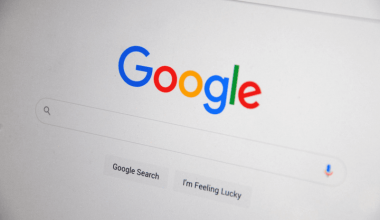User-generated content (UGC) is transforming how brands interact with their customers. It’s more than just a buzzword; it’s a powerful digital marketing strategy that is changing the way organizations develop trust, engage customers, and drive sales. As marketing experts, we’ve witnessed firsthand how user-generated content can propel a brand from obscurity to industry leader.
But what is user-generated content, and why should you care? Simply explained, it refers to any material created by your customers or supporters rather than your brand. This could include product reviews, social media posts, images, videos, or blog posts.
Now. When was the last time you purchased without first reading reviews or booked a hotel without browsing traveler photos? That’s the power of user-generated content work—authentic, relatable, and incredibly persuasive. So, how can you effectively use CGC to elevate your brand? Let’s dive into it.
Key Takeaways
- User-generated content (UGC) is valued because it provides genuine insights from real customers, making it more relatable and trustworthy than traditional advertising. This authenticity fosters deeper trust and connection with potential customers.
- Reviews are highly influential, with many consumers relying on them as much as personal recommendations. Highlighting honest feedback, including negative reviews, can enhance transparency and trustworthiness.
- High-quality user-generated photos and videos, such as unboxing clips or product reviews, captivate audiences more effectively than text alone. These visuals can create a stronger emotional connection and keep users engaged on social platforms.
- Running photo contests or creating branded hashtags encourages users to generate content, increasing brand visibility. These initiatives can produce a wealth of shareable content while building a sense of community.
- Collaborating with influencers to create user-generated content can significantly extend a brand’s reach. Influencers bring credibility and encourage their followers to engage with and trust the brand.
What Is User Generated Content?
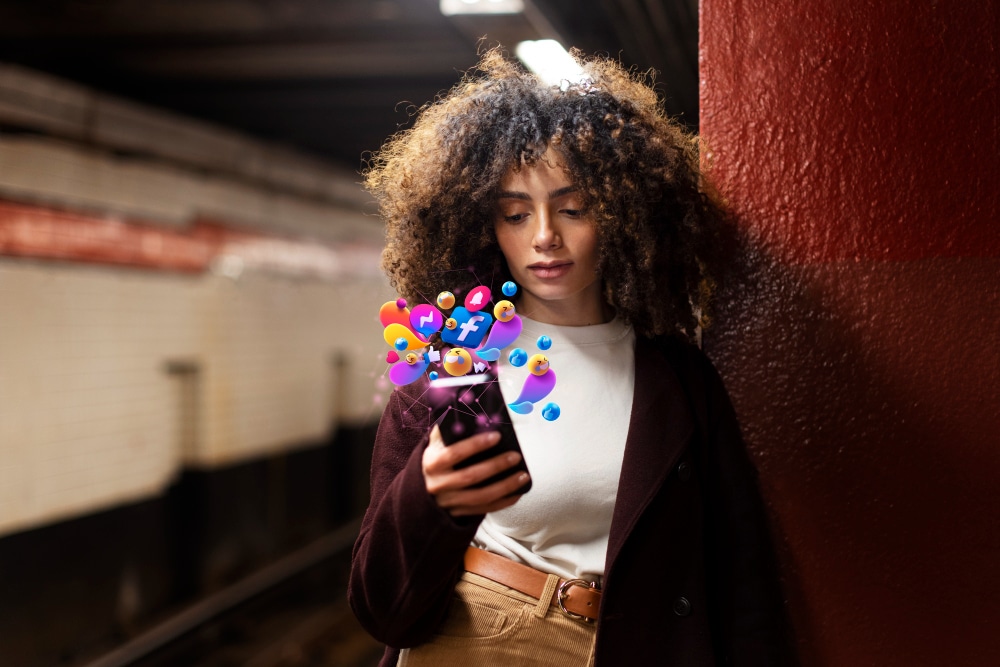
User-generated content (UGC) or consumer-generated content is brand-specific content created by individuals rather than brands, often in response to their experiences with a product or service. Unlike branded content, user-generated content showcases genuine opinions, emotions, and experiences that other consumers are likelier to trust and relate to.
Think about the last time you looked through social media and came across a buddy bragging about their new purchase or sharing an unboxing video. That is an example of customer-generated content in action. CGC refers to any customer-created content, including as images, videos, reviews, testimonials, and social media posts, that features or references a brand’s products or services.
I remember a little coffee shop in my area launching a campaign inviting customers to share images of their drinks with a specific hashtag. It wasn’t long before my page was overflowing with lovely photos of lattes, cozy atmosphere, and happy faces sipping their coffee. It seemed real, like a heartfelt endorsement from a friend, and it made me want to try it out myself. That’s the power of CGC—it’s authentic, relatable, and more trustworthy than traditional brand content.
Types of User-Generated Content That Boost Brand Credibility
User-generated content comes in many forms, each with unique benefits. Let’s explore some of the most effective types:
#1. Customer Reviews
These types of reviews are most effective on your product page. They do more than you may know in convincing people to choose your product. Take a look at these statistics about customer reviews gathered from a marketing company called BrightLocal.
- 91% of 18-34-year-olds believe in online reviews just as much as they trust personal recommendations from people that they know.
- 68% of consumers have to see a minimum of 4 customer reviews before they make their decision to trust a brand.
- 40% of consumers are put off and will discontinue their business with a brand after they have seen negative reviews about that brand.
Consumers value this type of UGC because it allows them to make more informed selections and reduces the chance of losing money due to a poor product or service.
Also, you can try to remove all of the negative or average reviews about your brand, but customers “need” such negative evaluations since they receive the impression that you are honest and not just trying to be’salesy’.
Amazon originally used user reviews in 1995, when it allowed purchasers to post questionnaires about the things they bought. This increased people’s trust in Amazon, and it is still the most popular online shopping and selling destination.
This is proof that this feedback is essential for helping your potential customers see what real users of your brand are saying about you in direct speeches.
#2. User Generated Photo Reviews
When you stop by to see an ad, visuals capture your attention first, followed by the headline and the remainder of the ad’s content.
That is why, in today’s environment, consumers are put off by poor image quality.
So, swap “good enough” photos for “perfect” ones the next time you select images for your product or service, and your audience will notice your content and branding. If you hire influencers to create photographs for you, make sure they utilize a DSLR camera and understand light, composition, and the rule of thirds, when applicable.
This is because the better your photos from a third party, the better the engagement you will get. Now, if you take a quick look at GoPro’s Instagram account, you will find that they maximize the power of images through their constant sharing of cool action shots by their customers. This demonstrates the photographic wonders and possibilities users are exposed to if they use a GoPro.
#3. Video Reviews
Aside from enticing consumers to buy from your brand, videos are a great method to keep people interested on your social media profiles and blog. The more engaged your user films are, the more your customers form a personal connection with the video creator and your business as a result.
You can draw inspiration from Android’s “Friends Forever” film, which was the most shared video ad in 2015, according to video ad tech provider Unruly.
The curation must have taken a while, but it was, in essence, a straightforward video showing a series of unlikely animals palling as BFFs, like a monkey climbing off and (promptly falling off of) a horse’s back or a parrot generously giving spaghetti to a husky—exciting stuff to watch.
#4. Photo Contests
This is an excellent method to engage your fans, raise awareness, create photo content, and improve your community. The success of premium whiskey brand Macallan demonstrates the significance of picture contests.
The brand held an Instagram online photo contest in which fans had to take photos of themselves with the whiskey bottle using the hashtag #meandthemacallan. In the end, five winners received undetermined Macallan awards.
The images are also advertised for this contest on their Facebook page and Twitter feed to increase participation.
#5. Influencer Content
This is a pretty easy-to-use UGC that will only involve you partnering with influencers to promote your brand. Note, however, that to get results, you will need more than just influencers.
Milton & King used 45 influencers to raise its brand awareness in the US. The influencers engaged generated 158 pieces of content, which resulted in 83,971 direct engagements.
In the long run, they reached more than 980,000 consumers and won over 10,000 new followers on social media.
How to Use User-Generated Content to Showcase Your Brand and Build Trust and Credibility
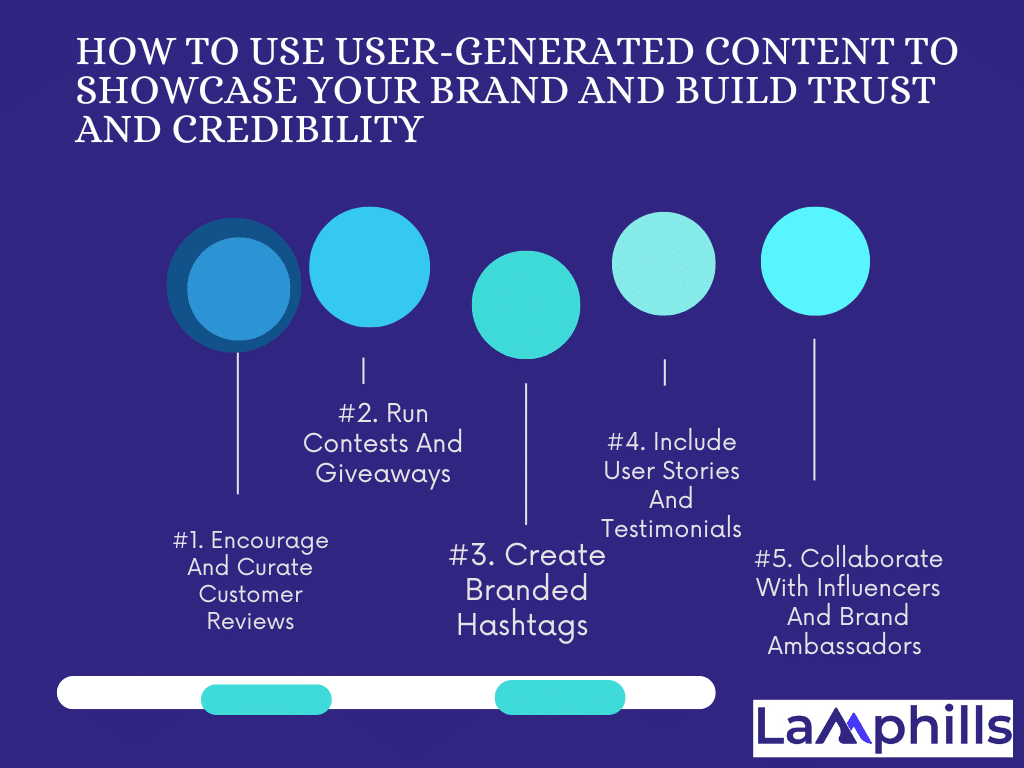
User-generated content is an effective tool for showing a brand’s identity while also creating trust and credibility. By using the power of user-generated content, brands can tap into their customers’ actual experiences and viewpoints, generating a feeling of community and a closer connection with their target audience.
From the standpoint of consumers, user-generated material is a welcome change from traditional advertising. It enables customers to witness actual individuals using and interacting with a brand’s products or services, which can be more relatable and credible than polished marketing campaigns. User-generated content provides a forum for consumers to share their opinions, experiences, and recommendations, empowering them to become brand advocates and influencers in their own right. Now, let’s dive into the in-depth information about using the power of user-generated content:
#1. Encourage And Curate Customer Reviews
Sometimes the greatest method to obtain CGC is to simply ask. Following the transaction, send a follow-up email encouraging them to post a review or share their experience on social media.
Customer reviews are an important type of user-generated material that can significantly impact purchasing decisions. Brands may encourage customers to post reviews by providing incentives or having a simple review process. Curating these reviews and displaying them on product pages or social media platforms can give social proof and foster trust among potential consumers.
#2. Run Contests And Giveaways
Everyone enjoys the opportunity to win something, and contests are an excellent method to encourage customers to contribute content. Consider awarding a prize in return for the greatest photo or story about your product.
I previously assisted a skincare firm in running a “Glow Up Challenge” in which consumers shared before-and-after images of their goods. The winner earned a year’s worth of skincare products. Not only did this produce hundreds of entries, but it also supplied the company with an abundance of genuine testimonials to promote on their website and social media.
Contests and freebies are great strategies to promote user-generated content. By encouraging participants to develop and share material about the brand or its products, such as photos, videos, or testimonials, brands can generate a buzz and increase engagement. Offering attractive prizes can incentivize users to participate and create high-quality content.
#3. Create Branded Hashtags
This guide will walk you through each stage of a branded hashtag strategy, offering insights, examples, and tips for success.
Branded hashtags are an effective way to collect and organize user-generated material. Brands can encourage users to share their experiences and content with a unique hashtag linked with their brand or campaign. This not only aids in the curation of user-generated content but also boosts brand visibility and reach.
#4. Include User Stories And Testimonials
Sharing user stories and testimonials is an effective technique to demonstrate the influence of a brand’s products or services. Brands can contact satisfied consumers and urge them to share their experiences, whether through written testimonials, videos, or interviews. Brands may increase credibility and trust with potential customers by publishing these stories on their websites or social media platforms.
#5. Collaborate With Influencers And Brand Ambassadors
Partnering with influencers and brand ambassadors who share the business’s values and target demographic can increase the reach of user-generated content. These influencers can provide information about their experiences with the company and encourage their followers to do the same. This collaboration not only creates real material but also helps to reach a larger audience.
Remember that these are only a few ways to use the power of user-generated content. Each brand can adjust its approach to its individual objectives and target audience. By adopting user-generated content, organizations can tap into their customers’ collective creativity and authenticity, resulting in a strong marketing tool that increases trust, credibility, and brand loyalty.
Best Practices When Launching A User-Generated Content Strategy
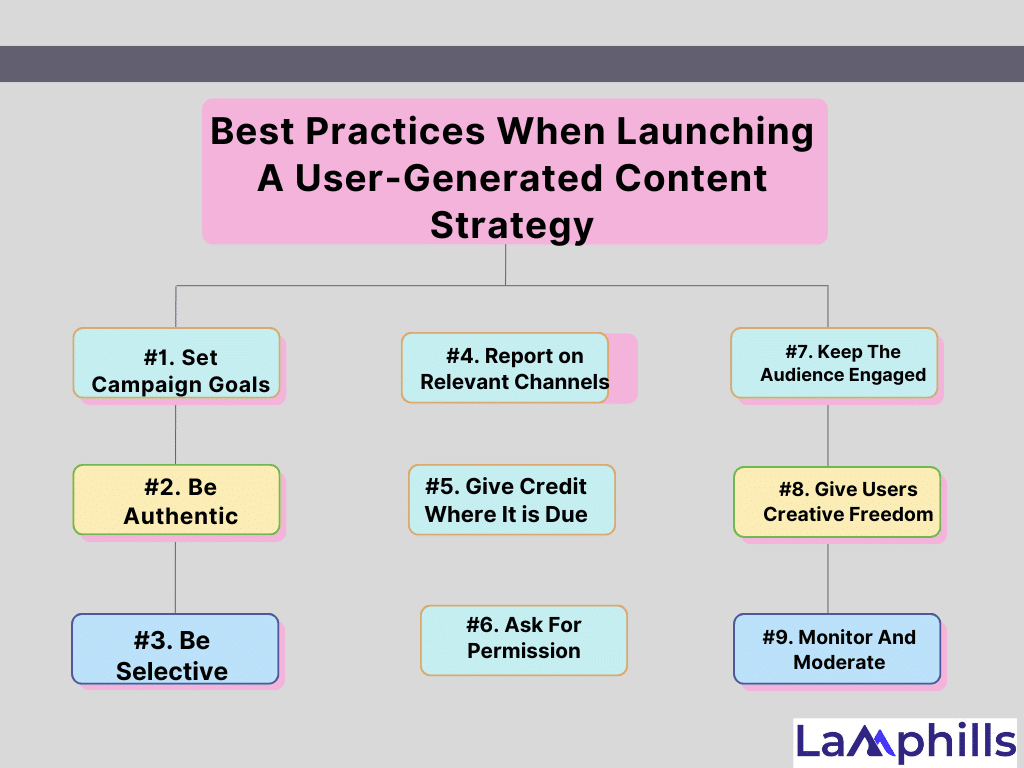
If you attempted implementing a user-generated content strategy and it didn’t go as planned, you may not have followed best practices. Here are some points to consider when beginning a user-generated content marketing strategy:
#1. Set Campaign Goals
Before you begin collecting user-generated content, you must first establish a clear aim. Having a particular aim, whether it is to increase brand awareness, improve customer trust, or drive sales, will allow you to measure the success of your campaign.
#2. Be Authentic
Do not edit user-generated content to match your brand’s narrative. Fake or highly edited content is obvious and can harm your brand’s reputation. Accept the legitimacy of user-generated content, even if it isn’t always flawless.
#3. Be Selective
Not all user-generated content is suitable for your brand. Make sure to curate and select content that aligns with your values and resonates with your target audience. This way, you can maintain a consistent brand image and avoid controversies.
#4. Report on Relevant Channels
Determine the user-generated content platform where your target audience is most active and potential supporters have the most influence. TikTok, for example, is popular among Generation Z, whereas older populations prefer Facebook. Also, consult your statistics to understand where you should direct your UGC efforts and which forms of UGC work best on each platform.
#5. Give Credit Where It is Due
Give appropriate credit and recognition to the original creator of the content. This demonstrates appreciation for their work and contributes to the development of customer relationships. People are more likely to continue providing content for your brand if they feel valued.
#6. Ask For Permission
Consent is critical when employing user-generated content. Always obtain permission from the original artist before sharing their content, especially if you intend to utilize it in social media marketing campaigns.
You can request permission by contacting the content creator directly by private message or comment, clearly describing your interest in their content and how you intend to use it. If they agree, preserve a record of their approval in case any problems emerge.
#7. Keep The Audience Engaged
Don’t simply collect UGC and save it on your website or social media pages. Engage your audience by reacting to comments, reposting their work, and praising them for their contributions. This promotes a sense of camaraderie around your brand and encourages others to join in.
#8. Give Users Creative Freedom
When encouraging users to create content, provide them with creative freedom and avoid imposing too many restrictions. Allowing users to express themselves uniquely can lead to more diverse and authentic content that users are more likely to engage with.
#9. Monitor And Moderate
Track all user-generated content about your brand to address negative feedback and protect your brand’s image. A dedicated team monitoring UGC is crucial for larger brands.
Benefits of Using User-Generated Content for Your Brand
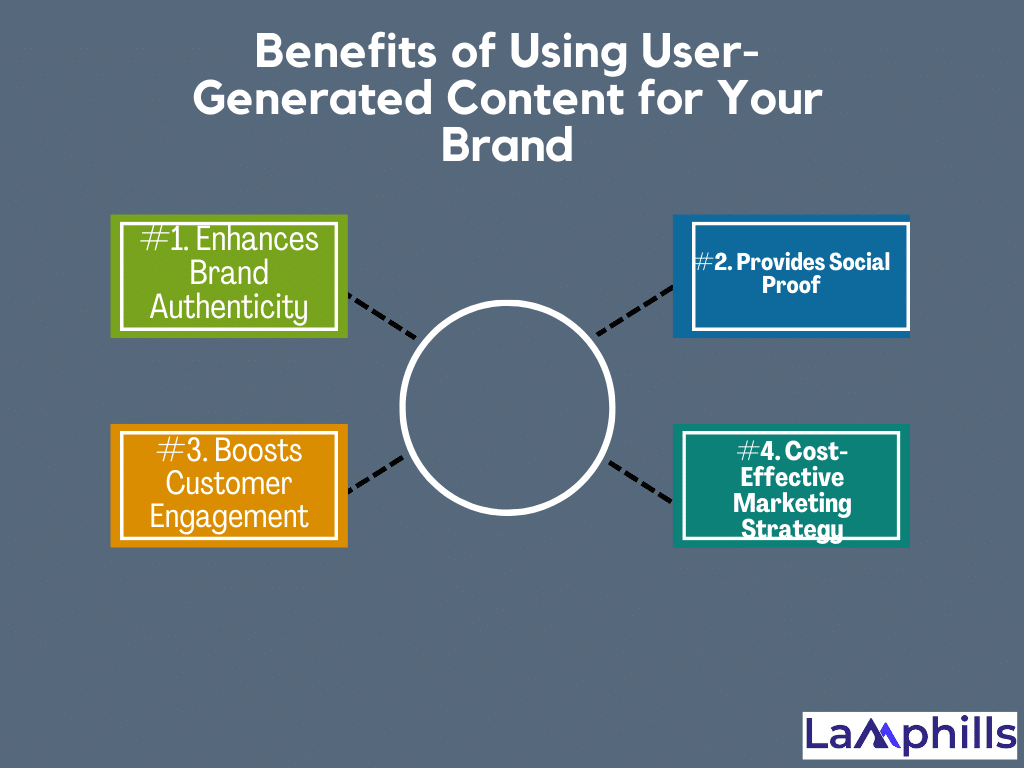
Below are a few out of various benefits if using UGC for your brand:
#1. Enhances Brand Authenticity
Authenticity is essential for creating trust. People want to feel like they’re interacting with real people behind a brand. CGC makes your brand appear more honest and true because it is a genuine tale from a real person rather than polished advertising.
For example, a cosmetics firm I worked with began emphasizing customer testimonials on their website and social media channels. Instead of only using studio-shot shots, they posted photos of real people with various skin tones and types using their products. The response was incredible. Customers enjoyed the variety and the ability to see actual results from real people. It helped the brand appear more approachable and reliable.
#2. Provides Social Proof
We all enjoy getting a positive recommendation from someone we trust. It’s human nature. When potential buyers see others enjoying your product or service, they gain a sense of social proof. It’s like a gentle nudge that says, “If others like this, maybe I will too.”
Imagine you’re looking for a new pair of running shoes online and come across photographs of joyful runners flaunting their new kicks. It’s a lot more convincing than a generic product photo. A buddy once told me she bought a pair of sneakers simply because she kept seeing them on her social media feed from happy runners. She felt more confidence in her purchase because of the positive feedback and photographs from other consumers.
#3. Boosts Customer Engagement
Encourage your customers to share their experiences to improve brand recognition while also fostering a sense of community. Customers get more invested in a business when they believe they are a part of its story.
I saw this firsthand while working at a local gym. We urged members to share their workout transformation photos and tag the gym’s account. The results were incredible: members were inspired to report their accomplishments, the gym’s account attracted new followers, and engagement increased. It became a positive feedback loop, with more posts, increased engagement, and more new members.
#4. Cost-Effective Marketing Strategy
Producing quality content can be costly and time-consuming, but CGC provides a more cost-effective approach. By encouraging your customers to create content, you’re essentially tapping into a vast pool of pre-made marketing material.
Why is UGC so powerful?
UGC enables consumers to participate in the brand’s growth. This strengthens brand loyalty because people become part of a larger community of people who share common experiences.
What is the difference between CGC and UGC?
UGC is often shared for fun, to inform, or to express oneself without aiming to promote a brand. In contrast, CGC is shared to talk about specific experiences with products or services, offering valuable feedback for brands and potential customers
Conclusion
User or customer-generated content is a treasure trove of authenticity and trust. By encouraging your customers to share their stories, you can build a brand that feels more real, relatable, and trustworthy. Whether you’re a small business or a global brand, its a tool that can elevate your marketing game without breaking the bank.
References
Related Articles
- How to Create and Share User-Generated Content on Social Media (+ Examples)
- Best User Generated Content Platforms for Your Brand in 2024: How to Choose the Best One
- 12+ Creative Content Ideas for Social Media to Keep Your Followers Engaged
- 8 Customizable Brand Strategy Templates + How to Create an Effective Strategy





